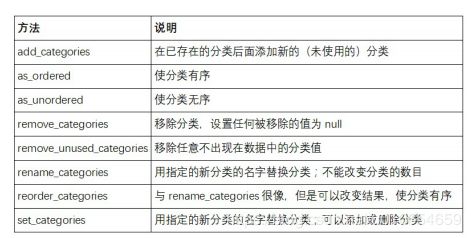第12章 pandas高级应用
12.1 分类数据
有一些数据会包含重复的不同值的小集合的情况。可以用unique和value_counts进行分类提取。
import numpy as np
import pandas as pd
values = pd.Series(['apple', 'orange', 'apple','apple'] * 2)
pd.unique(values)#可以统计不同值
pd.value_counts(values)#可以统计不同值的频次
apple 6
orange 2
dtype: int64
values = pd.Series([0, 1, 0, 0] * 2)
dim = pd.Series(['apple', 'orange'])
print(dim.take(values))
0 apple
1 orange
0 apple
0 apple
0 apple
1 orange
0 apple
0 apple
dtype: object
pandas的分类类型
fruits = ['apple', 'orange', 'apple', 'apple'] * 2
N = len(fruits)
df = pd.DataFrame({'fruit': fruits,
'basket_id': np.arange(N),
'count': np.random.randint(3, 15, size=N),
'weight': np.random.uniform(0, 4, size=N)},
columns=['basket_id', 'fruit', 'count', 'weight'])
print(df)
basket_id fruit count weight
0 0 apple 8 3.781360
1 1 orange 14 2.288399
2 2 apple 7 3.645629
3 3 apple 6 3.695826
4 4 apple 3 0.346048
5 5 orange 4 0.061197
6 6 apple 6 1.797600
7 7 apple 4 3.433174
fruit_cat = df['fruit'].astype('category')
print(fruit_cat)
0 apple
1 orange
2 apple
3 apple
4 apple
5 orange
6 apple
7 apple
Name: fruit, dtype: category
Categories (2, object): [apple, orange]
c = fruit_cat.values
type(c)
pandas.core.arrays.categorical.Categorical
c.categories#返回出唯一值
Index(['apple', 'orange'], dtype='object')
c.codes#返回出索引
array([0, 1, 0, 0, 0, 1, 0, 0], dtype=int8)
#直接创建pandas分类类型的数据
my_categories = pd.Categorical(['foo', 'bar', 'baz', 'foo', 'bar'])
my_categories
[foo, bar, baz, foo, bar]
Categories (3, object): [bar, baz, foo]
#如果已经有了分类的编码,可以通过from_code导入或者添加编码类型
categories = ['foo', 'bar', 'baz']
codes = [0, 1, 2, 0, 0, 1]
my_cats_2 = pd.Categorical.from_codes(codes, categories)
my_cats_2
[foo, bar, baz, foo, foo, bar]
Categories (3, object): [foo, bar, baz]
#可以指定一个顺序
ordered_cat = pd.Categorical.from_codes(codes, categories,
ordered=True)
ordered_cat
#输出[foo < bar < baz]指明‘foo’位于‘bar’的前面
[foo, bar, baz, foo, foo, bar]
Categories (3, object): [foo < bar < baz]
#无序的分类实例可以通过as_ordered排序:
my_cats_2.as_ordered()
[foo, bar, baz, foo, foo, bar]
Categories (3, object): [foo < bar < baz]
用分类进行计算
np.random.seed(12345)
draws = np.random.randn(1000)
draws[:5]
array([-0.20470766, 0.47894334, -0.51943872, -0.5557303 , 1.96578057])
bins = pd.qcut(draws, 4)
bins
[(-0.684, -0.0101], (-0.0101, 0.63], (-0.684, -0.0101], (-0.684, -0.0101], (0.63, 3.928], ..., (-0.0101, 0.63], (-0.684, -0.0101], (-2.9499999999999997, -0.684], (-0.0101, 0.63], (0.63, 3.928]]
Length: 1000
Categories (4, interval[float64]): [(-2.9499999999999997, -0.684] < (-0.684, -0.0101] < (-0.0101, 0.63] < (0.63, 3.928]]
bins = pd.qcut(draws, 4, labels=['Q1', 'Q2', 'Q3', 'Q4'])
print(bins)
bins.codes[:10]
[Q2, Q3, Q2, Q2, Q4, ..., Q3, Q2, Q1, Q3, Q4]
Length: 1000
Categories (4, object): [Q1 < Q2 < Q3 < Q4]
array([1, 2, 1, 1, 3, 3, 2, 2, 3, 3], dtype=int8)
bins = pd.Series(bins, name='quartile')
results = (pd.Series(draws)
.groupby(bins)
.agg(['count', 'min', 'max'])
.reset_index())
print( results)
quartile count min max
0 Q1 250 -2.949343 -0.685484
1 Q2 250 -0.683066 -0.010115
2 Q3 250 -0.010032 0.628894
3 Q4 250 0.634238 3.927528
用分类提高性能
N = 10000000
draws = pd.Series(np.random.randn(N))
labels = pd.Series(['foo', 'bar', 'baz', 'qux'] * (N // 4))
categories = labels.astype('category')
labels.memory_usage()
print( categories.memory_usage())
10000178
%time _ = labels.astype('category')
Wall time: 856 ms
分类方法
s = pd.Series(['a', 'b', 'c', 'd'] * 2)
cat_s = s.astype('category')
print(cat_s.cat.codes)
print('\n')
print( cat_s.cat.categories)
0 0
1 1
2 2
3 3
4 0
5 1
6 2
7 3
dtype: int8
Index(['a', 'b', 'c', 'd'], dtype='object')
#set_categories方法可以改变数据集中的分类类型
actual_categories = ['a', 'b', 'c', 'd', 'e']
cat_s2 = cat_s.cat.set_categories(actual_categories)
print(cat_s2)
0 a
1 b
2 c
3 d
4 a
5 b
6 c
7 d
dtype: category
Categories (5, object): [a, b, c, d, e]
可用的分类方法
为建模创建虚拟变量
pandas.get_dummies函数可以转换这个分类数据为包含虚拟变量的DataFrame
cat_s = pd.Series(['a', 'b', 'c', 'd'] * 2, dtype='category')
print(pd.get_dummies(cat_s))
a b c d
0 1 0 0 0
1 0 1 0 0
2 0 0 1 0
3 0 0 0 1
4 1 0 0 0
5 0 1 0 0
6 0 0 1 0
7 0 0 0 1
12.2 GroupBy高级应用
分组转换和“解封”GroupBy
df = pd.DataFrame({'key': ['a', 'b', 'c'] * 4,
'value': np.arange(12.)})
print(df)
key value
0 a 0.0
1 b 1.0
2 c 2.0
3 a 3.0
4 b 4.0
5 c 5.0
6 a 6.0
7 b 7.0
8 c 8.0
9 a 9.0
10 b 10.0
11 c 11.0
g = df.groupby('key').value
print(g.mean())
key
a 4.5
b 5.5
c 6.5
Name: value, dtype: float64
函数lambda x: x.mean()可以用平均值转换数据.
print(g.transform(lambda x: x.mean()))
0 4.5
1 5.5
2 6.5
3 4.5
4 5.5
5 6.5
6 4.5
7 5.5
8 6.5
9 4.5
10 5.5
11 6.5
Name: value, dtype: float64
# 每个分组的降序排名
print(g.transform(lambda x: x.rank(ascending=False)))
0 4.0
1 4.0
2 4.0
3 3.0
4 3.0
5 3.0
6 2.0
7 2.0
8 2.0
9 1.0
10 1.0
11 1.0
Name: value, dtype: float64
def normalize(x):
return (x - x.mean()) / x.std()
g.transform(normalize)
0 -1.161895
1 -1.161895
2 -1.161895
3 -0.387298
4 -0.387298
5 -0.387298
6 0.387298
7 0.387298
8 0.387298
9 1.161895
10 1.161895
11 1.161895
Name: value, dtype: float64
分组的时间重采样
N = 15
times = pd.date_range('2017-05-20 00:00', freq='1min', periods=N)
df = pd.DataFrame({'time': times,
'value': np.arange(N)})
print(df)
time value
0 2017-05-20 00:00:00 0
1 2017-05-20 00:01:00 1
2 2017-05-20 00:02:00 2
3 2017-05-20 00:03:00 3
4 2017-05-20 00:04:00 4
5 2017-05-20 00:05:00 5
6 2017-05-20 00:06:00 6
7 2017-05-20 00:07:00 7
8 2017-05-20 00:08:00 8
9 2017-05-20 00:09:00 9
10 2017-05-20 00:10:00 10
11 2017-05-20 00:11:00 11
12 2017-05-20 00:12:00 12
13 2017-05-20 00:13:00 13
14 2017-05-20 00:14:00 14
print(df.set_index('time').resample('5min').count())
value
time
2017-05-20 00:00:00 5
2017-05-20 00:05:00 5
2017-05-20 00:10:00 5
12.3 链式编程技术
管道方法
避免中间变量用不了。
'''
df = load_data()
df2 = df[df['col2'] < 0]
df2['col1_demeaned'] = df2['col1'] - df2['col1'].mean()
result = df2.groupby('key').col1_demeaned.std()
'''
'''
#下面的两段代码是等价的
# Usual non-functional way
df2 = df.copy()
df2['k'] = v
# Functional assign way
df2 = df.assign(k=v)
'''
"\n#下面的两段代码是等价的\n# Usual non-functional way\ndf2 = df.copy()\ndf2['k'] = v\n# Functional assign way\ndf2 = df.assign(k=v)\n"
说明:
放上参考链接,复现的这个链接中的内容。
放上原链接: https://www.jianshu.com/p/04d180d90a3f
作者在链接中放上了书籍,以及相关资源。因为平时杂七杂八的也学了一些,所以这次可能是对书中的部分内容的复现。也可能有我自己想到的内容,内容暂时都还不定。在此感谢原作者SeanCheney的分享
